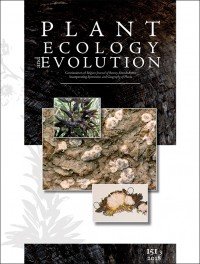Plant Ecology and Evolution Q2 Unclaimed
Plant Ecology and Evolution is a journal indexed in SJR in Plant Science with an H index of 39. It has an SJR impact factor of 0,424 and it has a best quartile of Q2. It has an SJR impact factor of 0,424.
Type: Journal
Type of Copyright:
Languages:
Open Access Policy:
Type of publications:
Publication frecuency: -


- €
Inmediate OANPD
Embargoed OA- €
Non OAMetrics
0,424
SJR Impact factor39
H Index29
Total Docs (Last Year)97
Total Docs (3 years)1636
Total Refs128
Total Cites (3 years)96
Citable Docs (3 years)1.29
Cites/Doc (2 years)56.41
Ref/DocOther journals with similar parameters
Journal of Applied Phycology Q2
Journal of Plant Biology Q2
Systematics and Biodiversity Q2
Fungal Ecology Q2
Fermentation Q2
Compare this journals
Aims and Scope
Best articles by citations
Phylogeny and circumscription of Sapindaceae revisited: molecular sequence data, morphology and biogeography support recognition of a new family, Xanthoceraceae
Origin and evolution of petals in angiosperms
Copper endemism in the Congolese flora: a database of copper affinity and conservational value of cuprophytes
Assessment of the functional role of tree diversity: the multi-site FORBIO experiment
Comparative ecology and coexistence of introduced and native congeneric forest herbs: Impatiens parviflora and I. noli-tangere
Inter- and intra-specific variability in seed dormancy loss and germination requirements in the Lavatera triloba aggregate (Malvaceae)
Forest herbs in the face of global change: a single-species-multiple-threats approach for Anemone nemorosa
Relating changes in understorey diversity to environmental drivers in an ancient forest in northern Belgium
The 'Mangrove Reference Database and Herbarium'
Contrasted taxonomic, phylogenetic and functional diversity patterns in semi-natural permanent grasslands along an altitudinal gradient
Molecular evidence for the polyphyletic origin of low pH adaptation in the genus Klebsormidium (Klebsormidiophyceae, Streptophyta)
Frustular morphology and polyphyly in freshwater Denticula (Bacillariophyceae) species, and the description of Tetralunata gen. nov. (Epithemiaceae, Rhopalodiales)
A combined analysis of morphological traits, chloroplast and nuclear DNA sequences within Santiria trimera (Burseraceae) suggests several species following the Biological Species Concept
Fungi from the roots of the terrestrial photosynthetic orchid Himantoglossum adriaticum
Fungal colonization of the invasive vine Vincetoxicum rossicum and native plants
Distribution of orbicules in Annonaceae mirrors evolutionary trend in angiosperms
Effects of fire disturbance on alpha and beta diversity and on beta diversity components of soil seed banks and aboveground vegetation
What constitutes Gomphonema parvulum? Long-term culture studies show that some varieties of G. parvulum belong with other Gomphonema species
Tree species identity outweighs the effects of tree species diversity and forest fragmentation on understorey diversity and composition
Is wind-mediated passive leaf movement an effective form of herbivore defence?
Small-scale diversity of plant communities and distribution of species niches on a copper rock outcrop in Upper Katanga, D.R.Congo
Biomass, phorophyte specificity and distribution of Tillandsia recurvata in a tropical semi-desert environment (Chihuahuan Desert, Mexico)
Specialist plant species harbour higher reproductive performances in recently restored calcareous grasslands than in reference habitats
View more
Comments